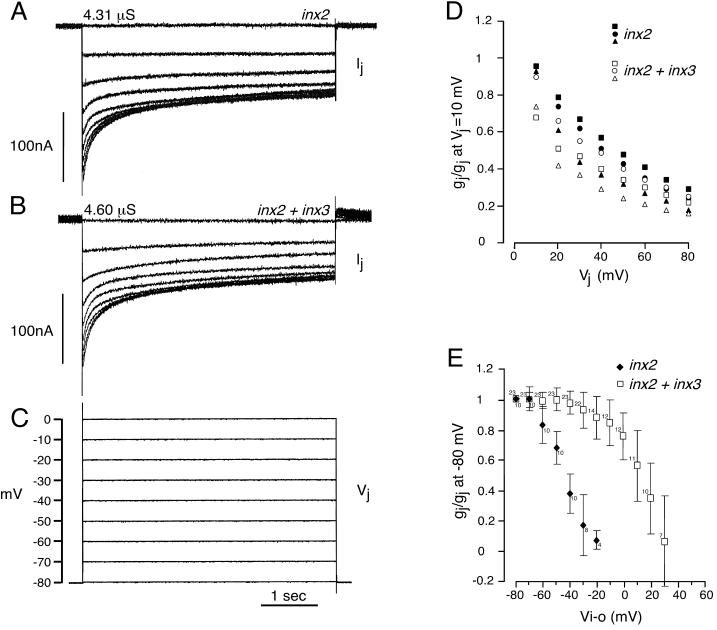Figure 5.
Electrical properties of Inx2 and Inx2+Inx3 channels. The intercellular channels formed when inx2 was expressed alone, and when inx2 was coexpressed with inx3 were differentially sensitive to applied voltage. Cells were individually microinjected with the mRNAs alone or in combination, paired, and recorded 1 day later using the double voltage-clamp technique. (A–C) Recordings from cell pairs injected with inx2 mRNA only (10 ng, A) and inx2+inx3 mRNAs (2 ng each, B). Both oocytes of a pair were initially clamped to a holding potential of −80 mV. Transjunctional voltages (Vj) were generated by depolarizing one cell of the pair in 10-mV steps (C) and the current (Ij) required to maintain its paired neighbor at the holding potential was simultaneously recorded (A, B). For the pairs shown, the maximum junctional conductances (Ij/Vj, measured at the beginning of the 10-mV step) were 4.31 μS (Inx2) and 4.60 μS (Inx2+Inx3). For the inx2+inx3-injected cell pair, this was slightly greater than the steady-state gj, because the channels were strongly voltage-dependent and began to close at Vj steps of 10 mV. Vj-dependent closure was very obvious for the second (20 mV) and subsequent, larger voltage steps for both inx2- and inx2+inx3-injected cell pairs (A, B). (D) gj/Vj relation for the inx2 and inx2+inx3 pairs shown in (A) and (B) (inx2+inx3, □; inx2, ▪) and additional cell pairs with conductances up to 6.04 μS. Data were normalized to the maximum instantaneous gj at a Vj of 10 mV. Cell pairs injected with inx2 and inx3 tended to show slightly more voltage sensitivity than pairs injected with inx2 only, particularly for smaller Vj steps. (E) gj/Vi-o relation. Both oocytes of a pair were stepped equally and simultaneously over a range of negative and positive membrane potentials (Vi-o). At each potential, a 10-mV depolarizing pulse was delivered to one cell to measure gj; values (±SD for numbers of pairs indicated) were normalized to gj at −80 mV. Data shown are from pairs with conductances in the range 0.5–20 μS. Restricting the analysis to pairs with gjs of 5 μS or below did not change these curves significantly. Intercellular conductances in oocyte pairs expressing inx2 only (filled symbols) were significantly more sensitive to Vi-o than gjs in pairs expressing both innexins (open symbols).

